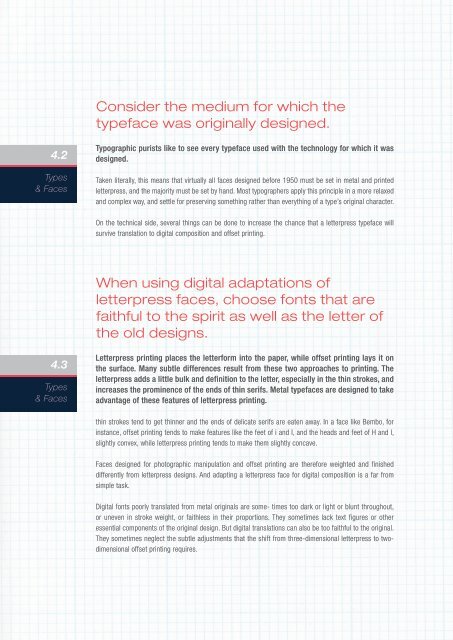5 Trick Pony Brand Guidelines v3
Create successful ePaper yourself
Turn your PDF publications into a flip-book with our unique Google optimized e-Paper software.
Consider the medium for which the<br />
typeface was originally designed.<br />
4.2<br />
Types<br />
& Faces<br />
Typographic purists like to see every typeface used with the technology for which it was<br />
designed.<br />
Taken literally, this means that virtually all faces designed before 1950 must be set in metal and printed<br />
letterpress, and the majority must be set by hand. Most typographers apply this principle in a more relaxed<br />
and complex way, and settle for preserving something rather than everything of a type’s original character.<br />
On the technical side, several things can be done to increase the chance that a letterpress typeface will<br />
survive translation to digital composition and offset printing.<br />
When using digital adaptations of<br />
letterpress faces, choose fonts that are<br />
faithful to the spirit as well as the letter of<br />
the old designs.<br />
4.3<br />
Types<br />
& Faces<br />
Letterpress printing places the letterform into the paper, while offset printing lays it on<br />
the surface. Many subtle differences result from these two approaches to printing. The<br />
letterpress adds a little bulk and definition to the letter, especially in the thin strokes, and<br />
increases the prominence of the ends of thin serifs. Metal typefaces are designed to take<br />
advantage of these features of letterpress printing.<br />
thin strokes tend to get thinner and the ends of delicate serifs are eaten away. In a face like Bembo, for<br />
instance, offset printing tends to make features like the feet of i and I, and the heads and feet of H and I,<br />
slightly convex, while letterpress printing tends to make them slightly concave.<br />
Faces designed for photographic manipulation and offset printing are therefore weighted and finished<br />
differently from letterpress designs. And adapting a letterpress face for digital composition is a far from<br />
simple task.<br />
Digital fonts poorly translated from metal originals are some- times too dark or light or blunt throughout,<br />
or uneven in stroke weight, or faithless in their proportions. They sometimes lack text figures or other<br />
essential components of the original design. But digital translations can also be too faithful to the original.<br />
They sometimes neglect the subtle adjustments that the shift from three-dimensional letterpress to twodimensional<br />
offset printing requires.





